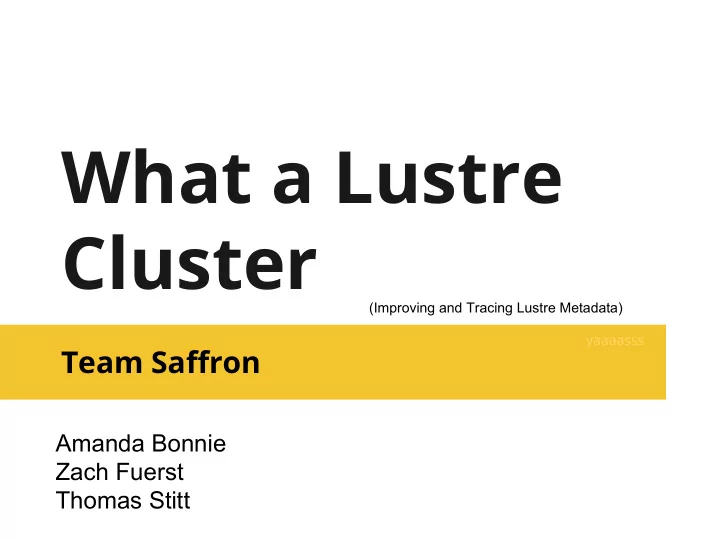

What a Lustre Cluster (Improving and Tracing Lustre Metadata) yaaaasss Team Saffron Amanda Bonnie Zach Fuerst Thomas Stitt
Overview ● Motivation ● Configuration ● Tracing Metadata ● Improving Metadata Hardware ● Multiple Lustre Clients via Virtualization ● Conclusions & Future Work 2
Motivation ● Tracing Metadata Motivation Can we get enough information without too much overhead? ○ ● Improving Metadata Hardware Motivation MDS can be a performance bottleneck ○ Faster MDT ☞ better performance? ○ ● Lustre Client Virtualization Motivation Single Lustre Client/Node underutilized IB device ○ Higher throughput ☞ Less transfer agents needed ○ Multi-VM nodes ☞ better throughput? ○ 3
Lustre Configuration TAMIRS PROBE ● ● MASTER (sa-master) MASTER (n01) ○ ○ 4 X OSS (sa02-sa05) 5 X OSS (n02-n05,n11) ○ ○ Single disk RAID0 8 disk RAID0 ■ ■ 1 X MGS/MDS (sa01) 1 X MGS/MDS (n06) ○ ○ 2 X CLIENTS (n07-n08) hdd, nvme, KOVE ■ ○ 5 X CLIENTS (sa06-sa10) ○ 2 X VM CLIENTS (n09-n10) ○ MDS/ OSS MGS MASTER CLIENTS MDT OST 4
MDS Tracing 5
Tracing Metadata ● Test tool: mdtest ● Tracers ○ Lustre Debug ○ debugfs (ftrace) ● Mask ○ ftrace - create, open, link, unlink, readdir, getattr, setattr ○ Lustre Debug - no mask 6
Tracing Metadata - Results quite an not too bad overhead ideal 7
MDS Hardware 8
Improving Metadata Hardware ● HDD ○ meh. (96.7 MB/s write & 206 MB/s read) ● NVMe ○ Fast! (686MB/s write & 1.3GB/s read) ● KOVE Express Disk (XPD) ○ RAM Storage Appliance ○ FAAAST! (2.8GB/s write & 3.5GB/s read) 9
Improving Metadata Hardware - Testing ● mdtest ○ Concerned with node caching (dropped caches!) ○ Performance still “low” ● MDS-Survey ○ Runs on MGS/MDS ○ Independent of CLIENT and OSS nodes. 10
Improving Metadata Hardware - Results hdd to hdd to nvme to nvme (%) kove (%) kove (%) create 19.57 20.12 0.46 lookup -1.67 0.99 2.70 md_getattr -0.12 4.72 4.85 setxattr 287.45 244.46 -11.09 destroy 43.45 46.83 2.36 PERCENT INCREASE FROM NVME TO HDD, KOVE TO HDD, & KOVE TO NVME 11
Lustre Client Virtualization 12
SR-IOV 13
Multiple Lustre Clients via Virtualization ● Enable SR-IOV ● KVM hypervisor with Centos 6.6 VMs on top ● Attach n Virtual Functions (VF) to the Physical Function (the device) ■ Virtual Functions just interfaces ■ n ∈ [1-11] 14
Testing Client Performance ● IOR ● Trinity Test from NERSC ○ POSIX Only ● N to N writes/reads ○ 44.7 GiB File per Client ● 10K, 100K, 1MB transfer sizes 15
IOR Write Results 16 (dashed lines are native installs)
IOR Read Results 17 (dashed lines are native installs)
VM Problems ● Hardware Restrictions ○ More than 2GB Ram Needed ○ Only 12 physical Cores ● IB Subnet Manager Needed on Host ● VMware’s ESXi Hypervisor ○ Mellanox drivers for ESXi didn’t support SR-IOV, only pass-through ○ Not Free 18
Conclusions ● MDS Tracing ○ Large Overhead or Not Extensive ● MDS Hardware ○ Improvements << Cost ● Virtualization of Clients ○ Scalable! ○ Worth Further Exploration 19
Future Work ● More Virtualization! ○ Put VMs in a VM so we can virtualize our virtualization allowing us to virtualize while we virtualize (and manage SR-IOV better) ■ Changing the number of VFs requires a reboot which is slow ○ Greater number of VMs (>11) ● Local subnet on each host ● SR-IOV with verbs on ESXi 20
Future Work ● More Virtualization! ○ Put VMs in a VM so we can virtualize our virtualization allowing us to virtualize while we virtualize (and manage SR-IOV better) ■ Changing the number of VFs requires a reboot which is slow ○ Greater number of VMs (>11) ● Local subnet on each host ● SR-IOV with verbs on ESXi 21
Acknowledgements Mentors : Brad Settlemyer, Christopher Mitchell, Michael Mason Instructors : Matthew Broomfield, Jarrett Crews Administration : Carolyn Connor, Andree Jacobson, Gary Grider, Josephine Olivas 22
Questions? 23
Recommend
More recommend